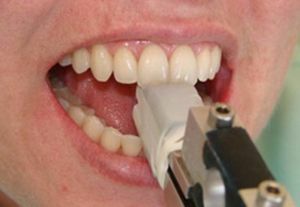 Chewing activity is an important indicator of the state of the dentofacial structure. This is the power of the chewing muscles of the lower jaw, which is necessary for biting, crushing and crushing food. It is measured on separate segments of the dentoalveolar system.
Chewing activity is an important indicator of the state of the dentofacial structure. This is the power of the chewing muscles of the lower jaw, which is necessary for biting, crushing and crushing food. It is measured on separate segments of the dentoalveolar system.
Gnathodynamometry is a method of measuring the pressure of the muscles of the chewing apparatus, as well as the durability of the dental tissues to the force of compression of the jaws.
This technique is implemented by means of a device called a gnathinamometer.
Most authors working with this topic took as a unit the chewing power of the weakest tooth. And the pressure of other teeth was determined in comparison with it. When calculating the constant of the chewing pressure, the author was guided by the following anatomical features of the tooth:
- surface dimensions;
- number of roots;
- presence of bumps;
- the interval from the angle of the lower jaw;
- cross-section of the neck;
- features periodontal disease.
Content
- Procedure
- study on the practical value of the index
- Pages
- stories Chewing efficiency Agapov
- Amendment Oxman
Order study
Measuring masticatory stress can be carried out using an electronic gnathodynamometer ruby and Perzashkevicha. The 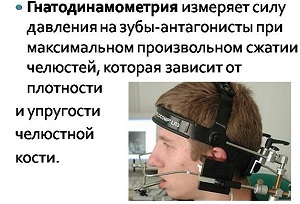 includes special sensors integrated in the measuring head of the removable attachment. In the sensor, connected with a microammeter, there is a brass plate.
includes special sensors integrated in the measuring head of the removable attachment. In the sensor, connected with a microammeter, there is a brass plate.
The patient is conveniently located in the chair. No psychological stress is necessary. In the mouth between the jaws, the nozzle is inserted and compressed by the teeth until pain appears. At the moment, the pressure is displayed on the scale of the instrument. The indicators are fixed.
On the practical value of the
indicators Gnathodynamic parameters depend on many factors:
- of the human sex;
- individual features;
- diseases( periodontitis, periodontitis and others);
- partial loss of teeth;
- of the age.
Indicators on the device are reflected in kilograms. The average data range from 15-35 for the front and 45-75 kg for the molars. They are essential for optimizing the prosthetic process, since they reveal the sensitivity of the periodontal to the functional load, helping to determine the design of the necessary prosthesis.
determined average chewing pressure, taken as the basis of measurements and compliance with load endurance periodontal:
- on the incisors in females - 20-30 kg;
- on molars for women - 40-60 kg;
- on the incisors in men - 25-40 kg;
- on molars for men - 50-80 kg.

chewing pressure on each tooth in kilograms
There are tables of different authors with the distribution of chewing forces on each tooth, they are also approximate. Endurance periodontal tissues in general( 1408 kg - for men and 936 kg for women) is not implemented almost never because the maximum power reduction of the masticatory apparatus is equal to 390 kg.
Gnatometriya seldom used in modern dentistry because of the following shortcomings:
- vertical pressure is measured only when there is no accounting horizontal force;
- results can not be called absolutely accurate;
- there is a rapid deformation of the spring;
- , in addition, the results also determine the psychosomatic state, which even for the same person changes during the day.
wonder - what will happen if you do not replace the lost prosthetic posterior teeth:
Pages
stories 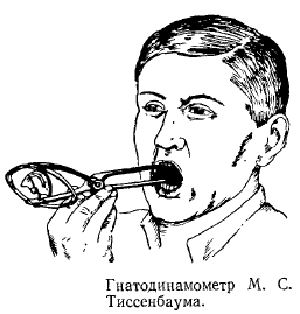 Chewing power began to be measured in the 7th century. The most famous anatomist and physiologist of the time, Giovanni Borelli, is considered the first to make such attempts. His method is pretty simple. On the rope, tied behind the lower tooth, attached weight, causing muscle resistance. The weight limits of weights were 200 kg. The disadvantage of this method is that the work of the muscles of the cervical musculature, which also took part in the resistance, was not taken into account.
Chewing power began to be measured in the 7th century. The most famous anatomist and physiologist of the time, Giovanni Borelli, is considered the first to make such attempts. His method is pretty simple. On the rope, tied behind the lower tooth, attached weight, causing muscle resistance. The weight limits of weights were 200 kg. The disadvantage of this method is that the work of the muscles of the cervical musculature, which also took part in the resistance, was not taken into account.
The next innovator in this field was at the end of the XIX century Black. He is considered the first author of the gnathodynamometer. The first device consisted of two plates with a spring between them and resembled a rotor-expander. The device was improved in 1919 by Haber, and in 1941 - by Thyssenbaum MS.In these devices only vertical chewing load was determined.
In 1948, Kleitman IAconstructed a dynamometer that also undergoes horizontal pressure. The design of instruments is being improved to the present day. Instruments are electronic, photometric, mechanical.
Chewing efficiency according to Agapova
Methodology Agapova N.I.based on the calculation of the strength of each of the teeth as a percentage of the entire chewing apparatus. 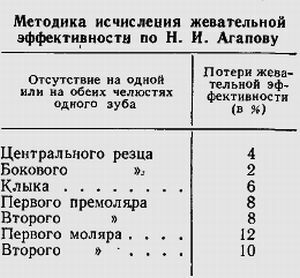
As a rule, to estimate the violations of the chewing apparatus, a general count of the number of teeth is used. Agapov believes this is fundamentally wrong. After all, their strength and effectiveness is different. He developed a table that distributes the coefficients between the teeth.
An important correction is his conclusion that the teeth are effective only in pairs. Teeth that have lost antagonists are practically deprived of their basic function. Therefore, in the absence of one tooth, the absence of two is noted. And the calculation of the masticatory activity should accordingly be based on the number of pairs of teeth. When using this correction, the values are quite different.
Oksman corrections
In turn Oksman IMindicates the importance and necessity of taking into account the activity of the remaining teeth in accordance with their mobility. At the first degree of pathological mobility of the tooth, the chewing activity corresponds to 100%.At the second degree - 50%, and at the third - absence of chewing activity is ascertained. To the third degree also belong the teeth affected by periodontitis.
Oksman, taking into account the developments of Agapov, introduced the recording of antagonist teeth in the form of fractions. The figures indicating the loss of chewing activity are recorded in this order: in the numerator - the maxillary index, in the denominator - in the mandibular. According to this scheme, it is more convenient for a doctor to imagine the condition of the dentoalveolar apparatus.
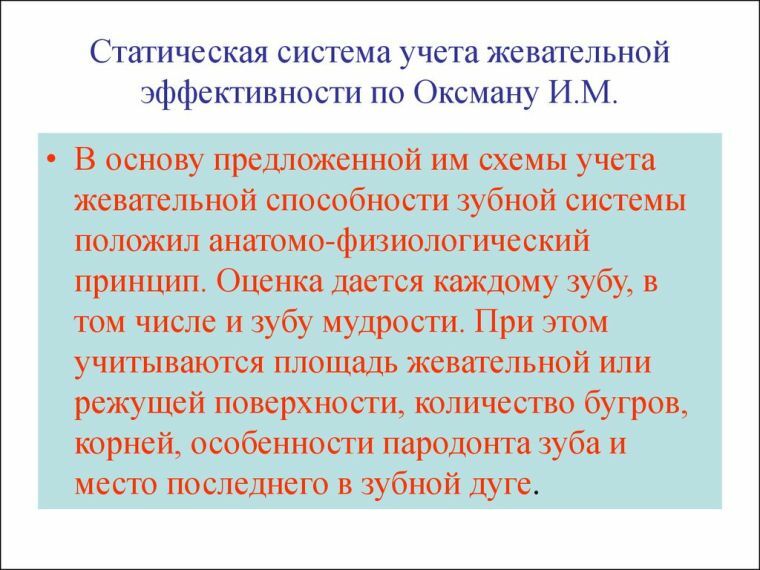
Gnathinometric data are important in orthodontics and dental prosthetics. Their significance is affected by: psychological experiences, compensatory abilities of periodontal receptors, reactivity of measurement and numerous other factors.
Through gnatometry: measuring the force of pressure between pairs of teeth, assessing the functionality of the prosthesis, monitoring the dynamics of therapeutic measures and the functionality of the implants.
